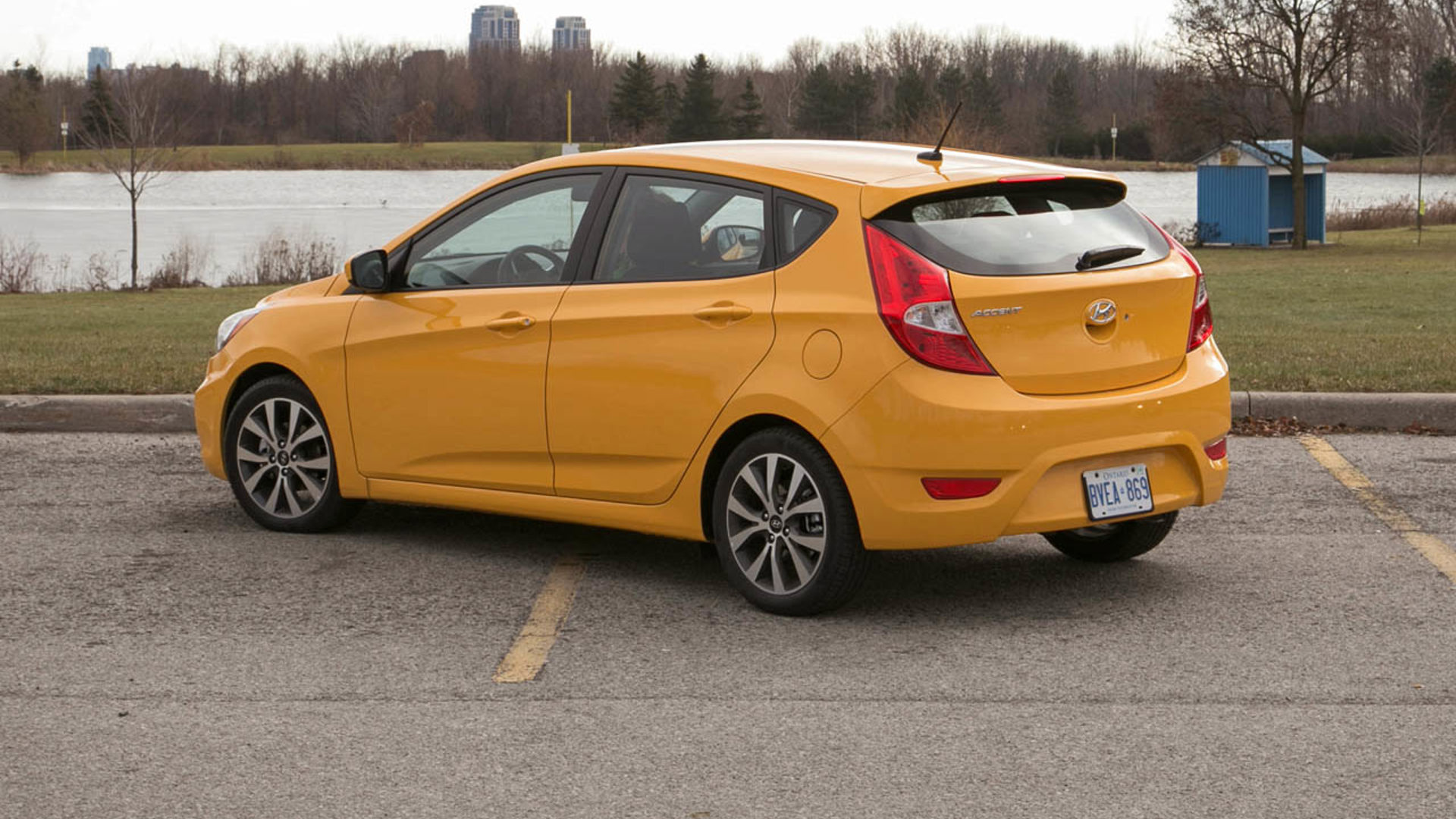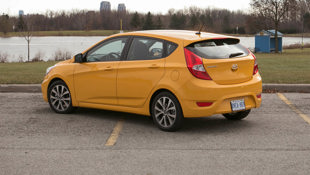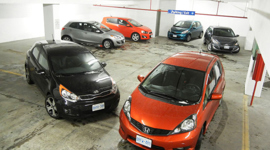Vehicle Type
Compact sedan / Five-door
Owners typically rave about the Accent’s great looks, great overall value, surprisingly roomy cabin, relatively high-quality feel, and good performance from the braking system.
History / Description
With a new platform, a new powertrain and significantly advanced styling, the current-generation Hyundai Accent hit the market for model-year 2012, with a major focus on lightweight design, striking looks, highly relevant standard feature content offerings, and selection galore. Available in both sedan and five-door configurations, and with numerous trim grades to choose from, Accent offered plenty of choice for the shopper after a thrifty and efficient compact ride.
Primary competitors included the Honda Fit, Nissan Versa Note, Toyota Yaris and Ford Fiesta.
Depending on the model selected, feature content may include automatic climate control, a sunroof, 16-inch alloy wheels, projector headlamps, a leather-wrapped steering wheel, automatic lights, and plenty more. Notably, the automatic lighting system includes welcome headlights with an escort function, which activates the headlights via remote when the doors are unlocked, and leaves them on after you park, adding security when approaching or leaving your Accent in a dark parking lot or driveway.
All units offered antilock brakes, six airbags, Brake Assist, Traction Control and Stability control. When it launched, Accent was the only car among subcompact competitors to offer active front head restraints and four wheel disc brakes as standard – representing Hyundai’s approach to stepping up their compact car game a few notches. Same story with the Accent’s dimensions: despite sub-compact car dimensions, Hyundai’s latest model was actually classified as a compact by Transport Canada on account of its interior volume. Surprising head and legroom are on offer, and Accent even has the biggest glovebox in its segment.
Engines / Trim
Hyundai stepped up their game in the powerplant department, too. All units offered a six-speed transmission for optimal mileage and performance, while a four-cylinder Gasoline Direct Injection (GDI) engine was standard. With 138 hp and a new, weight-optimized body structure, Accent boasted one of the best power-to-weight ratios in the segment. Where nomenclature is concerned, the “L” designation was worn by basic models, with GL and GLS ascending the model ranks.
What Owners Like
Owners typically rave about the Accent’s great looks, great overall value, surprisingly roomy cabin, relatively high-quality feel, and good performance from the braking system. Peppy performance, good mileage and a comfortable ride round out the package. Many owners say they appreciate the extra space and flexibility enabled by the five-door model’s folding rear seats and deep cargo hold.
What Owners Dislike
Common gripes include a hard-to-read stereo system display, and sub-par performance from the factory headlight system. Some owners wish for sharper and more agile handling, perhaps via a slightly stiffer suspension.
Here’s a look at some owner reviews.
The Test Drive
Accent appears to be largely reliable, though a few checks and tips are important to help shoppers find a top-notch second-hand copy of the popular model.
Start by inspecting the headlights. Many owners and reviewers have noted suboptimal performance from the headlights on earlier Accent models from this generation, and any yellowing on the lenses, condensation within the housings, or any fading or other damage could impede light output even further. If the headlight housings in the Accent you’re considering are in less-than-perfect shape, budget for a new set of headlight housings, or headlight lens polishing. Many owners have installed upgraded bulbs or supplemental lighting provisions to help compensate for mediocre headlight performance. Here’s some more reading on poor headlight performance.
When driving, turn off the radio and climate control fan, once you’ve confirmed that they work. Then, at low revs, press the throttle, and listen for a chirping, squealing or cricket-like noise from under the hood. The likely culprit is a rubber belt used to drive the alternator and other components. Some owners say the belt size was slightly too large from the factory on some units, while others say the belts stretch and wear out prematurely. In any case, replacing a stretched or worn belt is relatively easy and inexpensive.
Some owners have reported premature wear from the factory-installed brake components. Here’s some more reading. Inspect the brakes, or have a mechanic inspect the brakes, confirming that the seller isn’t trying to pass off a worn set of pads and rotors. Note that a squishy brake pedal, squealing or scraping sounds, or sluggish brake performance are all signs that the brakes on the Accent you’re considering need some attention.
Tires should also be inspected for signs of excessive wear.
Note that tire and brake wear is affected by numerous attributes, including driving habits, locale, and adherence to maintenance requirements. A mechanic should also inspect the Accent’s suspension components, especially if you detect any excessive bouncing, rebounding or softness on a test drive. Though inconclusive, some owners have reported replacement of factory shock absorbers at relatively low miles.
Have a technician scan the Accent’s Engine Control Module (ECM) for trouble codes, whether or not a Check Engine light is illuminated. In some cases, a past code is stored in the computer, and could provide a clue to a problem with the engine, or one of its sensors. Some owners have reported Code p0326, for instance, which can result from a problem with an engine knock sensor.
Other checks should include confirming proper operation of all power window switches, and checking the clutch on manual-equipped models for signs of slippage and wear, perhaps by applying the parking brake, selecting second gear, and slowly releasing the clutch pedal over the span of about 20 seconds. If the vehicle fails to stall as the clutch is released, the clutch may need to be replaced. A manual transmission that often grinds or bites back at you while shifting is another trouble sign.
Check the air conditioner system as well, confirming that it pumps cool air into the cabin in quick order once activated. Any unwelcome noises, lugging of the engine, or poor A/C performance should be investigated. Though largely inconclusive, some owners have reported A/C system performance issues that were actually caused by an overdue cabin air filter change, which is part of regular maintenance.
One final note: as the Accent runs a Direct Injection (DI) engine, valve gunk may become an issue over time. Owners of other models with DI engines from across most manufactures have reported issues to varying degrees. In checks of the usual sources, Accent doesn’t seem to be suffering from these issues, though owners are advised to ensure they stick to oil change intervals and use top-quality fuel at all fill ups, which may reduce or eliminate valve gunk buildup indirectly. Further, if any telltale signs of valve gunk are noted (poor performance, Check Engine lights referencing a misfire code), be sure to have the problem documented by your local Hyundai service centre, which can speed warranty claims, if required.
The Verdict
With a headlight bulb upgrade and a quick check-over by a technician, a used Accent from this generation should provide shoppers with affordable access to a comfortable, roomy and upscale compact car that’s noted for great fuel efficiency and value.
Just one recall.
Crash Test Scores
























